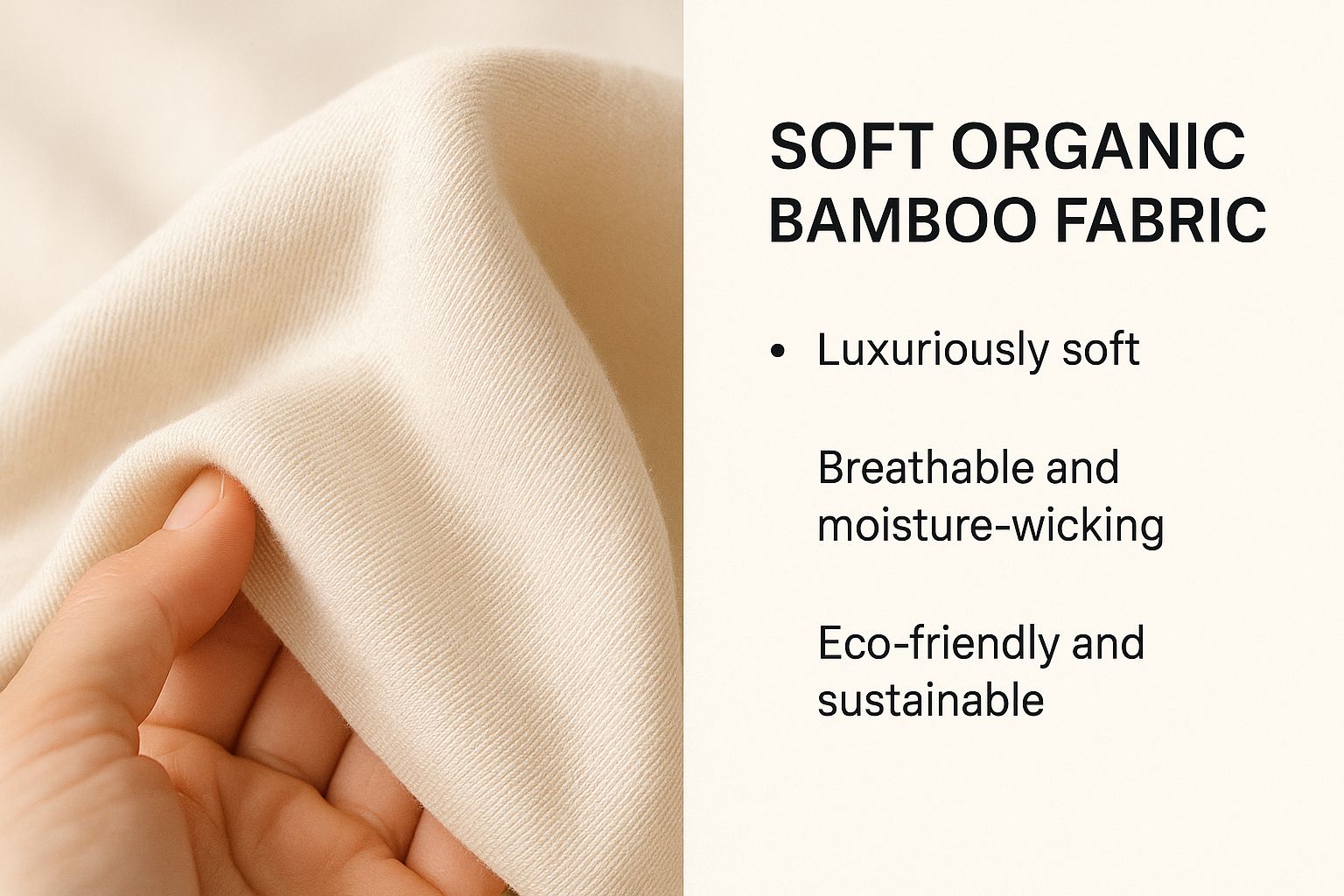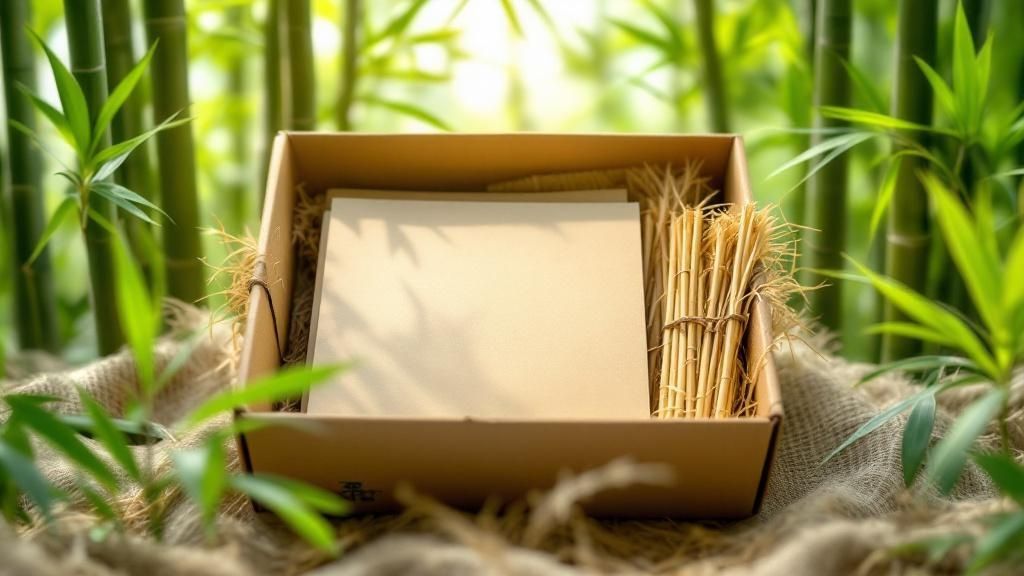Decoding What Makes Bamboo Sheets Truly Organic
Figuring out if organic bamboo sheets are the real deal can feel tricky, especially when brands throw around words like "natural" and "eco-friendly." The reality is, there's a huge difference between genuinely organic bedding and products that are just greenwashing. The "organic" label isn't just about how the bamboo is grown; it covers the entire journey from the bamboo grove to your bed.
Understanding this distinction is key. It helps you see which products are truly sustainable and which are just trying to look the part.
The Journey from Plant to Fabric
For bamboo sheets to be truly organic, the process has to start with bamboo grown without any synthetic pesticides or fertilizers. Bamboo is a rockstar plant—it grows fast and is naturally tough, so it often doesn't need much help. But the real test comes during manufacturing. There are two main ways to turn bamboo pulp into the soft fabric we love: the viscose process and the lyocell process.
The viscose process is very common, but it often involves harsh chemicals like sodium hydroxide and carbon disulfide to dissolve the bamboo. If this isn't done in a closed-loop system—where the chemicals and water are captured and reused—it can be harmful to workers and the local environment. This is where you, the shopper, need to become a bit of a detective.
Why Certifications Matter
The easiest way to cut through the marketing fluff is to look for official certifications. These are third-party seals of approval that confirm a company is following strict environmental and social standards.
- Global Organic Textile Standard (GOTS): Think of GOTS as the top-tier certification. It verifies that the bamboo is organically grown and that every step of manufacturing, from dyeing to finishing, is done responsibly.
- OEKO-TEX Standard 100: This label ensures that every single part of the product—down to the last thread and button—has been tested for harmful substances and is completely safe for you and your family.
True organic bamboo sheets, made from fibers grown without synthetic pesticides or GMOs, are popular for a reason. They are incredibly soft, breathable, and hypoallergenic, which is a game-changer for anyone with sensitive skin or allergies. The growing demand for organic bedding is clear, and you can see more about it by checking out these market insights on imarcgroup.com. When you choose certified organic bamboo, you're doing more than just buying new sheets; you're supporting a healthier planet and creating a safer, more comfortable place to sleep.
Why Your Sleep Quality Transforms With Bamboo Sheets

It’s one thing to hear about how great organic bamboo sheets are, but it’s another to experience how they can completely change your sleep. The secret is in the unique structure of the bamboo fiber itself, which helps create a personal microclimate that’s just right for deep, uninterrupted rest. If you're a hot sleeper or often deal with night sweats, this is where bamboo bedding really makes a difference.
The fabric is incredibly breathable, which lets air move freely and stops you from feeling stuffy or overheated. This breathability is paired with a natural ability to wick moisture away. Instead of absorbing sweat like cotton, bamboo pulls it away from your skin so it can evaporate. This keeps you feeling cool and dry all night long, leading to fewer wake-ups and much more restorative sleep.
A Fresher, Softer Sleep Environment
Beyond keeping you at the perfect temperature, organic bamboo sheets have other benefits that improve your nights. That silky-smooth feel isn’t just about luxury; the long, round fibers create a surface with very little friction. This is fantastic news for anyone with sensitive skin or acne because it cuts down on irritation and feels unbelievably gentle. You can explore these comfort benefits in more detail to see how they contribute to a better sleep experience.
On top of that, bamboo fibers have natural antibacterial qualities. This means your sheets resist odor-causing bacteria, staying fresher for longer between washes. Bamboo fibers are chosen for organic bamboo sheets because they are well-known for durability, moisture management, and these inherent antibacterial traits. This mix of features results in a cleaner, more hygienic place to sleep. If you're interested in the specifics, you can read the full research on the bamboo market. All these properties work together not just to give you new bedding, but to actively improve your quality of sleep.
Mastering Thread Counts and Weave Types Like An Expert
When you're shopping for new sheets, it's easy to get caught up in the thread count hype. For years, we've been told that a higher number automatically means better sheets. But when it comes to organic bamboo sheets, that's a bit of a myth. The fibers in bamboo are so fine and soft that the ideal thread count is actually between 250 and 400. A number higher than that can sometimes mean the manufacturer used thinner, less durable fibers just to boost the count, which might actually reduce the lifespan of your sheets.
So, if thread count isn't the main event, what is? The real game-changer is the weave. How the fabric is woven is what truly defines its feel, how well it breathes, and its overall character. Getting to know the different weaves is the secret to finding bedding you'll absolutely love.
Sateen vs. Twill: Choosing Your Comfort
The two most common weaves you'll find for bamboo sheets offer very different sleep experiences, and your personal preference is key here.
- Sateen Weave: If you dream of sliding into silky-smooth, hotel-quality sheets, sateen is for you. It's made with a "one-yarn-under, three-or-four-yarns-over" pattern that creates a luminous sheen and an incredibly soft feel. Sateen drapes beautifully and has a slightly warmer, cozier touch, making it perfect for anyone who wants to add a dash of luxury to their bedroom.
- Twill Weave: You'll recognize a twill weave by its subtle diagonal rib pattern. This structure gives the fabric fantastic durability and a slightly thicker, more substantial feel. It strikes a great balance between softness and strength, resists wrinkles better than other weaves, and holds up incredibly well to washing, making it a practical and long-lasting choice.
To help you decide which weave might be the right fit for your sleep style, here’s a quick comparison of the most popular options for bamboo sheets.
| Weave Type | Feel & Texture | Breathability | Best For | Care Level |
|---|---|---|---|---|
| Sateen | Silky, smooth, lustrous sheen | Good, but slightly warmer | Those who love a luxurious, hotel-like feel and a cozier sleep. | More delicate; prone to snagging. Requires gentle washing. |
| Twill | Soft, textured with a slight diagonal rib | Very breathable and durable | Anyone wanting a balance of softness and sturdiness that resists wrinkles. | Very durable and easy to care for, softens with each wash. |
| Percale | Crisp, cool, matte finish | Excellent, highly breathable | Hot sleepers and those who prefer a crisp, cool-to-the-touch feel. | Prone to wrinkling but very durable and gets softer over time. |
Ultimately, whether you lean towards the silky elegance of sateen, the balanced durability of twill, or the crisp coolness of percale, understanding the weave is your best bet for finding your perfect set of sheets.

This image really shows how the specific weave creates the final look and feel of the fabric. The choice between a sleek sateen and a sturdy twill really comes down to what you value most in your bedding—a silky finish for a touch of opulence or a more textured, durable fabric for everyday comfort.
Smart Shopping Without Breaking Your Budget
Finding quality organic bamboo sheets that feel luxurious without a hefty price tag can seem like a real challenge. It's easy to assume that a higher price means better quality, but that's not always the case. On the flip side, a rock-bottom price might signal poor craftsmanship that won't last. The secret is to look past the marketing fluff and understand what truly makes a set of sheets a good value.
Think of it this way: a well-made set from a brand that offers a lifetime warranty might cost more upfront, but it offers far more long-term value than a cheap set you'll just have to replace in a year.
Finding Value Beyond the Price Tag
When you're comparing sheets, the price should only be one part of the equation. To make sure you're getting a great deal on a product that will last, here are a few things I always check for:
- Look for Transparency: Does the company openly share what their sheets are made of? Look for specifics like "100% bamboo viscose" versus a vague "bamboo blend." Reputable brands are also proud to display certifications like OEKO-TEX, which confirms the fabric is free from harmful substances.
- Check Return Policies and Warranties: A company that believes in its product will back it up. A generous return policy is good, but a lifetime warranty is a huge green flag. It shows they're confident in their sheets' durability.
- Read Customer Reviews: Don't just skim the 5-star ratings. Dig into reviews that talk about how the sheets hold up after months of use and multiple washes. That’s where you’ll find the real story about long-term comfort and durability.
Seasonal Savings and Smart Customization
If you have a little patience, you can often score amazing deals. Many premium bedding brands run significant sales during major holidays like Black Friday or for End of Financial Year events. My pro-tip? Sign up for their newsletters to get a heads-up on upcoming discounts.
You also don't have to feel limited in your choices. The growing popularity of organic bamboo sheets means there's a wide variety of thread counts and designs available, so you can find something that fits your style and budget. You can even discover more about organic bedding trends to see how consumer preferences are shaping the market. By focusing on quality and timing your purchase right, you can absolutely get that luxury feel without the luxury price.
Protecting Your Investment With Proper Care

Once you've brought home a set of high-quality organic bamboo sheets, you'll want to make sure they stay as silky and soft as the day you got them. The great news is that keeping them in top condition is pretty straightforward. It just requires a slightly different routine than you might use for standard cotton or synthetic bedding. The very fibers that give bamboo its luxurious feel are also what make it susceptible to damage from harsh washing.
I like to think of it like caring for a favorite cashmere sweater—a little bit of gentle attention makes all the difference. The most common mistake people make is blasting them with hot water and using aggressive detergents, which can cause the delicate fibers to wear out and start pilling. If you want to get into all the details, we have a complete guide on caring for bamboo sheets that covers every question you might have.
Washing and Drying For Lasting Softness
To keep that signature smooth-as-silk feel, the secret is to be gentle. I've personally found these simple habits work wonders for keeping my own sheets feeling brand new, wash after wash:
- Stick to Cold Water: Always wash your sheets in cold water (a maximum of 30°C/86°F) on a gentle or delicate cycle. This simple change is crucial for protecting the fibers from damage or shrinking.
- Pick a Mild Detergent: Harsh chemicals are bamboo's biggest enemy. Look for a gentle, pH-neutral liquid detergent. It's also best to skip fabric softeners and bleach, as these can leave a residue that clogs the fibers and diminishes their natural ability to wick away moisture.
- Let Air Do the Work: Line-drying is hands-down the best method to keep your sheets perfect. If you need to use a machine, make sure it's on the lowest heat setting possible. Pull them out as soon as they're done to keep wrinkles at bay.
Following these tips isn't just about cleaning your bedding; it's about actively preserving the qualities that make organic bamboo sheets such a fantastic choice for a better night's sleep.
Understanding Your True Environmental Impact
Choosing organic bamboo sheets isn't just about getting a better night's sleep; it's a conscious decision about the environmental legacy you want to create. Think about this: traditional cotton is a notoriously thirsty crop, often requiring massive amounts of water to grow. Bamboo, on the other hand, is a superstar of self-sufficiency. It grows incredibly fast—sometimes several inches a day—and needs far less water, which means less strain on precious local water resources.
When you specifically choose certified organic bamboo, you're casting a vote for healthier farming. This certification guarantees that no synthetic pesticides or harsh fertilizers were used. This is a big deal because it helps prevent soil degradation, protects the local wildlife, and keeps dangerous chemical runoff out of our rivers and streams.
Beyond the Farm: The Full Lifecycle
The good news doesn't stop at the farm. The way bamboo is processed into fabric also matters. Many responsible manufacturers use closed-loop systems, a smart process that captures and reuses water and non-toxic solvents. This approach dramatically cuts down on waste and pollution, a stark contrast to many conventional textile factories that can release untreated chemicals into the environment. By supporting brands that commit to these cleaner methods, you're helping push the entire industry in a more sustainable direction. You can find more details on how bamboo's natural properties contribute to a healthier home on Bamtek Home's blog.
To give you a clearer picture, let's compare bamboo to other common bedding materials. This table breaks down the environmental footprint of each, from water use to what happens at the end of its life.
| Material Type | Water Usage | Growth Time | Chemical Use | Biodegradability | Carbon Footprint |
|---|---|---|---|---|---|
| Bamboo | Very Low (Relies mostly on rainfall) | 3-5 years to mature, then annual harvests | Minimal (naturally pest-resistant) | Fully biodegradable (if not chemically treated) | Low (absorbs significant CO2) |
| Cotton | Very High (up to 20,000 liters for 1kg) | Annual crop | High (heavy use of pesticides/insecticides) | Biodegradable | Moderate to High |
| Polyester | Low (during production) | N/A (fossil fuel-based) | High (petrochemicals) | Not biodegradable (takes 200+ years) | High (energy-intensive production) |
As you can see, bamboo stands out, especially when it comes to water conservation and avoiding harsh chemicals. While cotton is biodegradable, its intensive water and pesticide needs pose a significant environmental challenge. Synthetics like polyester have a much larger carbon footprint and create a long-term waste problem.
This shift toward eco-friendly home goods is becoming more common. As more of us learn about the health and environmental upsides of organic products, our collective choices are pushing the market toward greater sustainability. The research on the organic bedding market shows this trend is growing. Your decision to invest in organic bamboo sheets is a meaningful part of this movement, supporting farming practices that help restore and protect our planet for the future.
Your Practical Roadmap to Bamboo Sheet Success
Deciding to switch to organic bamboo sheets is an exciting upgrade for your bedroom, but it can feel like a big move. Let's break it down into a simple, practical plan. This isn't just about buying new bedding; it's about making a smart investment in your comfort and creating a sustainable sleep sanctuary without getting overwhelmed or going over budget.
The goal is to be thoughtful about your purchase, not just grab the first set you find online. It all begins with figuring out what you really need and finding the perfect product to match.
Building Your Action Plan
First things first, let's get down to the basics. Before you even start browsing, find a measuring tape. You need to know your mattress dimensions exactly, especially the depth. A lot of newer mattresses are quite thick, so look for fitted sheets with 18-inch pockets. This ensures a snug fit that won’t ride up and pop off the corners in the middle of the night.
Next, make a quick checklist to use when you're looking at different brands. It doesn't have to be complicated, but it should include these points:
- Certifications: Does the product have an OEKO-TEX or GOTS certification? This is a must-have to confirm the sheets are free from harmful substances and genuinely organic.
- Material Transparency: Check if the brand is upfront about its materials. You want to see 100% bamboo viscose (or lyocell) listed, with no hidden cotton or polyester blends diluting the quality.
- Customer Assurance: What kind of return policy or warranty do they offer? A company that provides a lifetime warranty is showing real confidence in how well its product will hold up.
Phasing In Your Investment
There's no need to buy a whole new bedding collection all at once. A smarter way to do it is to start with a single set of organic bamboo sheets. Give them a try for a couple of weeks. See how they feel against your skin and how they hold up after a wash or two. This lets you get used to their unique feel and care instructions.
Once you're happy with them and your budget allows, you can gradually add a matching duvet cover or some extra pillowcases. This way, you can build your dream bedding set over time. This approach lines up with a larger trend where more people are prioritizing comfort, long-term durability, and eco-friendly options. You can read more about these consumer insights to see how shopper priorities are changing.
Ready to start your journey to better sleep? Explore Bamtek's collection of 100% organic bamboo bedding and discover the difference for yourself.










